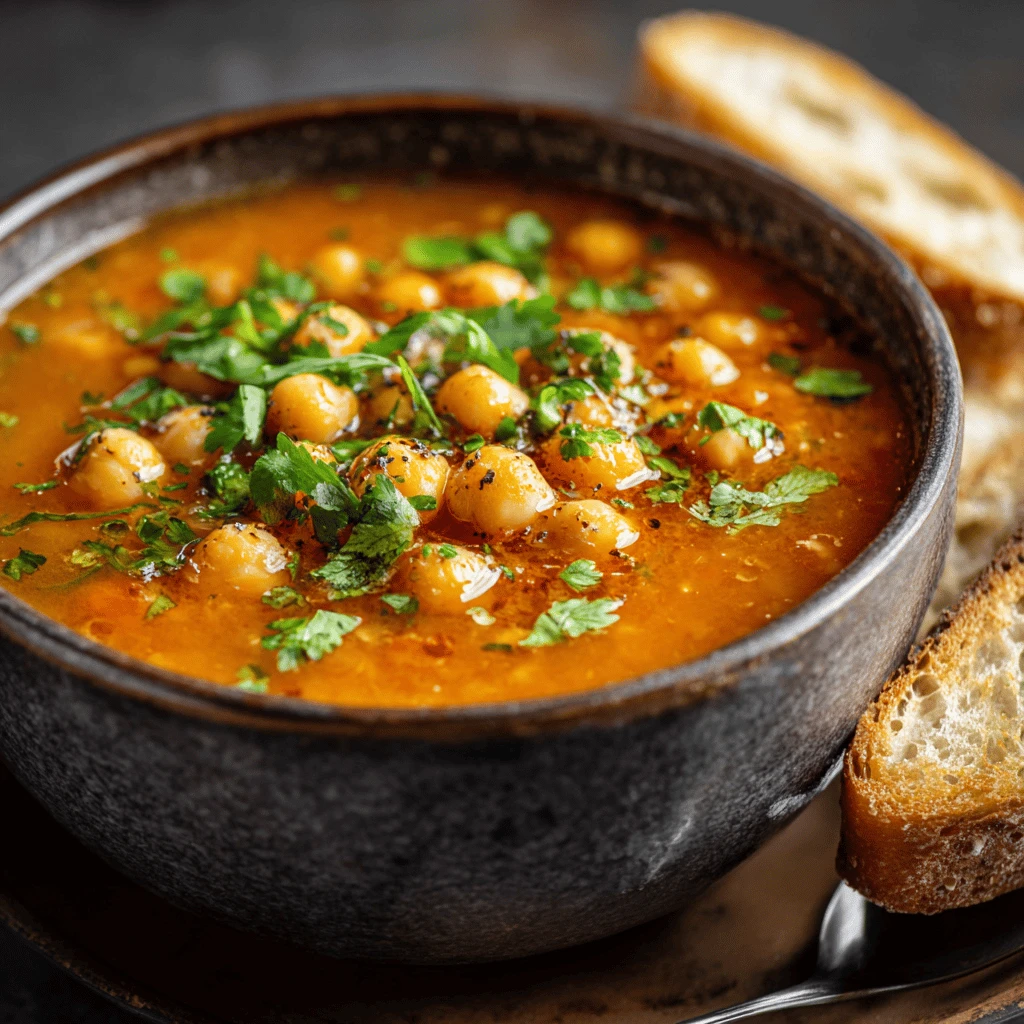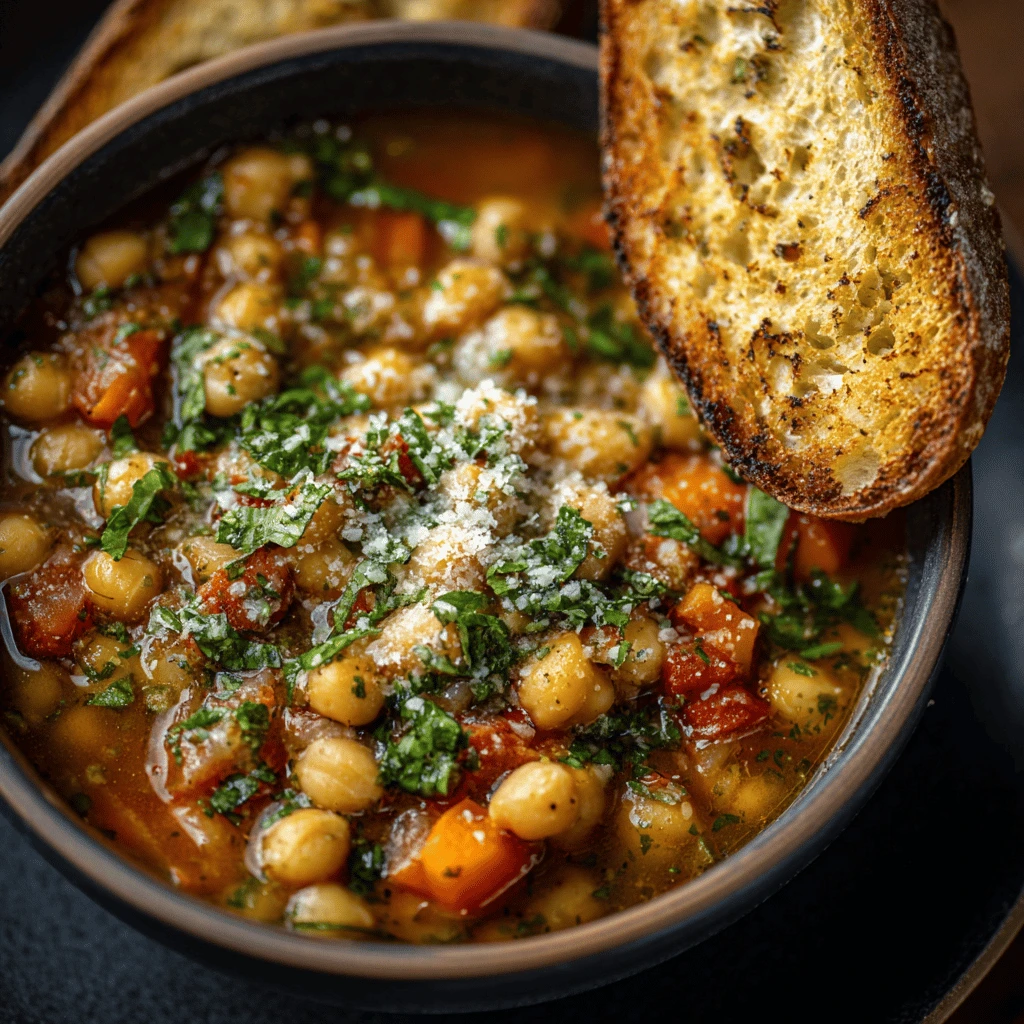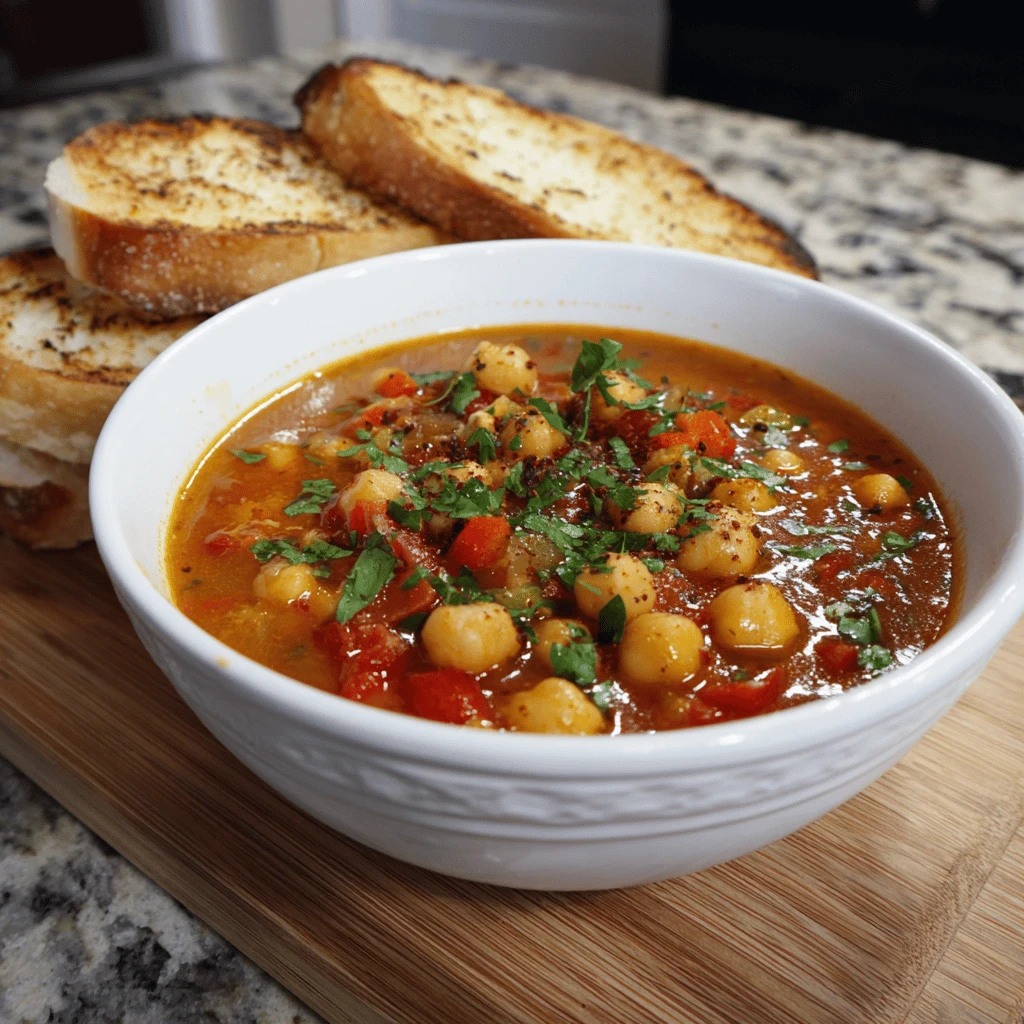Easy Mediterranean Chickpeas Soup
The Mediterranean diet is renowned for its health benefits and delicious, vibrant flavors. At the heart of this culinary tradition lies a wealth of plant-based recipes, and one that truly shines is Mediterranean chickpea soup. This recipe offers a delightful combination of simplicity, nourishment, and irresistible taste. This guide will walk you through creating the perfect bowl of easy Mediterranean chickpea soup in your own kitchen, with helpful tips and variations to suit your preferences.
Why Mediterranean Chickpea Soup is a Culinary Gem
Mediterranean chickpea soup isn’t just delicious; it’s a nutritional powerhouse. Chickpeas are an excellent source of plant-based protein, fiber, and various essential vitamins and minerals. This soup delivers a satisfying and wholesome meal. It’s packed with fiber, which aids digestion and promotes a feeling of fullness, making it a great option for weight management. Moreover, the vegetables commonly used in the soup, like tomatoes, carrots, and celery, contribute vital vitamins and antioxidants.
Beyond its health benefits, the ease of preparation makes this soup a winner. Using canned chickpeas drastically reduces cooking time, making it a perfect option for busy weeknights. With simple ingredients and minimal effort, you can create a flavorful and comforting meal that everyone will love.
The versatility of Mediterranean chickpea soup is another major advantage. You can easily adapt the recipe to your liking, adding different vegetables, herbs, or spices to create your unique flavor profile. It’s a great way to use up leftover vegetables in your fridge and experiment with different tastes.
The Essential Ingredients for Authentic Flavor
To create an authentic Mediterranean chickpea soup, you’ll need the following essential ingredients:
- Chickpeas: Canned chickpeas are a convenient option, but cooked dried chickpeas offer a richer flavor and texture. Rinse and drain them well before adding them to the soup.
- Aromatic Vegetables: Onion, carrots, and celery form the base of most great soups. Sautéing them in olive oil releases their flavors and creates a delicious foundation for the chickpea soup.
- Garlic: Fresh garlic is a must for Mediterranean cuisine. Mince it finely and add it to the sautéed vegetables for an aromatic boost.
- Tomatoes: Diced tomatoes, either canned or fresh, add acidity and depth of flavor to the soup. Crushed tomatoes can also be used for a smoother consistency.
- Broth: Vegetable broth is the standard choice, making this soup vegetarian and vegan. Chicken broth can also be used for a richer flavor.
- Olive Oil: Extra virgin olive oil is a staple of the Mediterranean diet and adds a characteristic flavor to the soup.
- Herbs & Spices: Dried oregano, thyme, bay leaf, and a pinch of red pepper flakes are common additions to Mediterranean chickpea soup. Fresh parsley or cilantro can be added as a garnish for added freshness.
- Lemon Juice: A squeeze of fresh lemon juice brightens up the flavors of the soup and adds a zesty touch.
Elevating the Flavor Profile with Optional Additions
While the essential ingredients form the foundation of a delicious Mediterranean chickpea soup, you can elevate the flavor profile with some optional additions:
- Spinach or Kale: Adding leafy greens like spinach or kale adds extra nutrients and a pleasant texture to the soup.
- Potatoes or Sweet Potatoes: Diced potatoes or sweet potatoes add a creamy and hearty element to the soup.
- Pasta or Rice: Small pasta shapes like ditalini or orzo, or cooked rice, can be added to the soup to make it a more substantial meal.
- Feta Cheese: Crumbled feta cheese adds a salty and tangy flavor that complements the chickpeas and vegetables.
- Olives: Chopped Kalamata olives add a briny and savory element to the soup.
- Sun-Dried Tomatoes: Chopped sun-dried tomatoes add an intense, concentrated tomato flavor.
Step-by-Step Guide to Making Delicious Chickpea Soup
Making Mediterranean chickpea soup is a straightforward process. Here’s a step-by-step guide to help you create a flavorful and satisfying meal:
1. Sauté the Aromatics: Heat olive oil in a large pot or Dutch oven over medium heat. Add chopped onion, carrots, and celery, and sauté until softened, about 5-7 minutes. Add minced garlic and cook for another minute until fragrant.
2. Add the Tomatoes and Spices: Add diced tomatoes, dried oregano, thyme, bay leaf, and red pepper flakes (if using) to the pot. Cook for a few minutes to allow the flavors to meld.
3. Incorporate the Chickpeas and Broth: Add rinsed and drained chickpeas and vegetable broth (or chicken broth) to the pot. Bring the soup to a boil, then reduce heat and simmer for at least 15-20 minutes to allow the flavors to develop. The longer it simmers, the better the flavor will become.
4. Adjust Consistency and Seasoning: If you prefer a thicker soup, you can use an immersion blender to partially blend the soup or remove a cup of the soup and blend it in a regular blender before returning it to the pot. Season with salt and pepper to taste.
5. Add Optional Ingredients: If using, add spinach, kale, potatoes, sweet potatoes, pasta, or rice during the last 10-15 minutes of cooking time, allowing them to cook through.
6. Finish with Lemon Juice and Garnishes: Remove the bay leaf from the soup. Stir in fresh lemon juice to brighten the flavors. Garnish with fresh parsley or cilantro, crumbled feta cheese, or a drizzle of olive oil before serving.
Expert Tips for Maximizing Flavor
- Use Quality Ingredients: The flavor of your chickpea soup will be greatly influenced by the quality of your ingredients. Use good quality olive oil, fresh vegetables, and flavorful broth for the best results.
- Don’t Skip the Sautéing: Sautéing the vegetables is an essential step in building flavor. Don’t rush this step – allow the vegetables to soften and release their natural sweetness.
- Simmer for Longer: The longer the soup simmers, the more the flavors will meld together. If you have time, simmer the soup for an hour or more for maximum flavor.
- Adjust Seasoning to Taste: Taste the soup frequently and adjust the seasoning as needed. Salt, pepper, and lemon juice can all be used to enhance the flavor.
- Add a Touch of Acidity: A squeeze of fresh lemon juice or a splash of vinegar at the end of cooking can brighten up the flavors and add a refreshing touch.
- Experiment with Herbs and Spices: Don’t be afraid to experiment with different herbs and spices to create your unique flavor profile. Smoked paprika, cumin, or coriander can add a warm and earthy flavor to the soup.
Serving Suggestions and Creative Variations
Mediterranean chickpea soup is delicious on its own, but it can also be served with a variety of accompaniments to create a complete meal. Here are some serving suggestions:
- Crusty Bread: Serve the soup with a side of crusty bread for dipping.
- Grilled Cheese Sandwich: Pair the soup with a grilled cheese sandwich for a comforting and satisfying meal.
- Salad: Serve the soup with a side salad for a light and healthy lunch.
- Toppings: Offer a variety of toppings for guests to customize their soup, such as crumbled feta cheese, chopped olives, fresh herbs, or a drizzle of olive oil.
Creative Variations to Try
- Spicy Chickpea Soup: Add more red pepper flakes or a pinch of cayenne pepper to the soup for a spicy kick.
- Creamy Chickpea Soup: Blend the soup until smooth and stir in a dollop of Greek yogurt or heavy cream for a creamy texture.
- Moroccan Chickpea Soup: Add spices like cumin, coriander, and turmeric to the soup for a Moroccan-inspired flavor.
- Lemon Chicken Chickpea Soup: Add shredded cooked chicken and extra lemon juice to the soup for a flavorful and protein-packed meal.
- Roasted Vegetable Chickpea Soup: Roast the vegetables before adding them to the soup for a deeper, more intense flavor.
Storage and Reheating Instructions
Mediterranean chickpea soup is a great make-ahead meal. It can be stored in the refrigerator for up to 3-4 days or frozen for up to 2-3 months.
- Refrigerator: Allow the soup to cool completely before transferring it to an airtight container. Store in the refrigerator for up to 3-4 days.
- Freezer: Allow the soup to cool completely before transferring it to freezer-safe containers or bags. Leave some headspace in the containers as the soup will expand when frozen. Freeze for up to 2-3 months.
To reheat the soup, thaw it in the refrigerator overnight if frozen. Heat the soup in a pot over medium heat until heated through. You can also reheat the soup in the microwave, stirring occasionally.
Frequently Asked Questions (FAQs)
Can I use dried chickpeas instead of canned?
Yes, you can use dried chickpeas. Soak them overnight, then cook them until tender before adding them to the soup. This will give a richer flavor.
Can I make this soup in a slow cooker?
Absolutely! Sauté the vegetables first, then transfer everything to the slow cooker and cook on low for 6-8 hours.
Is this soup vegan?
Yes, if you use vegetable broth. Be sure to check the labels of your ingredients to ensure they are vegan-friendly.
Can I add meat to this soup?
Yes, you can add cooked chicken, sausage, or lamb to the soup for added protein and flavor.
Can I freeze this soup?
Yes, it freezes well. Allow the soup to cool completely before transferring it to freezer-safe containers.
How can I make the soup thicker?
You can use an immersion blender to partially blend the soup or remove a cup of the soup and blend it in a regular blender before returning it to the pot. You can also add a slurry of cornstarch and water to thicken it.
What if I don’t have all the vegetables listed?
Feel free to use what you have on hand. The soup is very versatile, and you can easily substitute different vegetables based on your preferences.
How do I prevent the chickpeas from becoming mushy?
Avoid overcooking the soup. Add the chickpeas towards the end of the cooking process to prevent them from becoming too soft.




